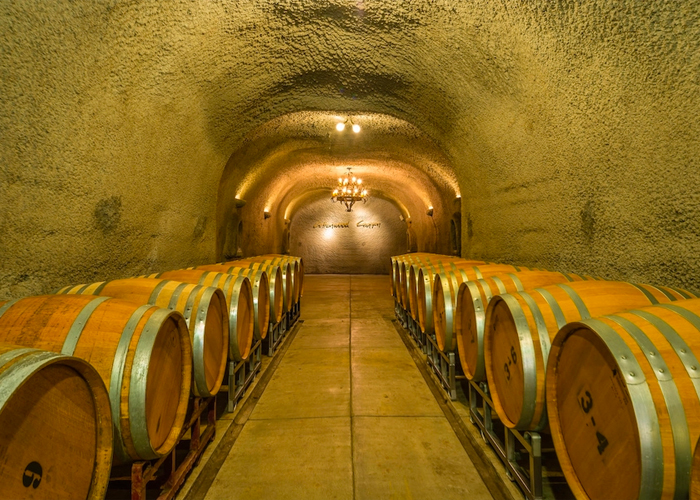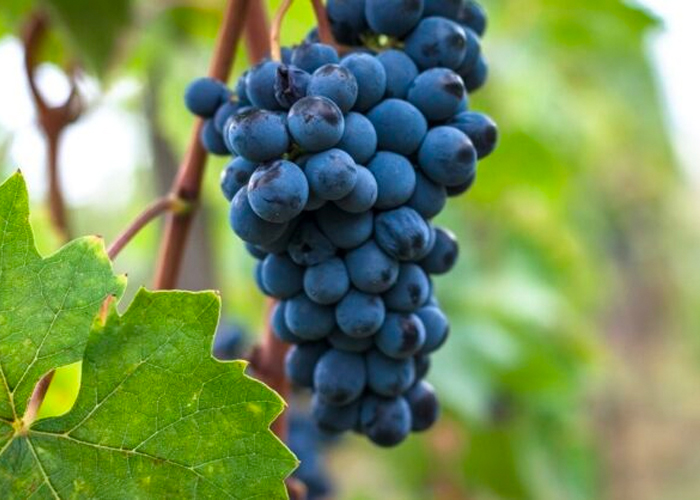The gallon jug California-grown Carlo Rossi Chianti is going to taste a lot different than the Chianti Classico DOCG imported from Italy, and it's not just because of the price point, although that probably also has something to do with it. Chianti and Chianti Classico are highly regulated wines primarily consisting of the Sangiovese grape blended with a small number of other varieties. California's chianti plays by different rules.
Italian immigrants arriving in California were instrumental in setting up the state's wine industry. Napa Valley and Sonoma are filled with wineries with Italian names, the result of immigrants settling there. Many of these are well-known, large-scale producers like Franzia, Gallo, Martini, and Mondavi. Despite this influence, and despite the fact that California's climate and soil more resemble Italy, French grapes dominated California vineyards for years.
Sangiovese grapes constitute at least 70% of Chianti in Italy, and Chianti Classico at least 80%, but the grape was not particularly popular in California. There were just a few acres of the grape grown in the state as late as 1980, according to Fred Tasker reported in the Chicago Tribune, and even by 1996, that number had only grown to 600 acres.
Not only did California miss out on growing the most important Chianti grape, but American drinkers didn't even know what a Sangiovese grape was, nor that the grape was supposed to be in their chianti.
Chianti Becomes an American Icon

One reason Americans didn't think all that hard about chianti was that it had long been an inexpensive table wine. That wasn't an accident, either.
In the early 20th century as Italian immigrants were pouring into the United States, Italian Chianti production was focused on quantity rather than quality. Eventually, this overproduction led to the Chianti Classico Consortium, a group of producers intent on restricting production and increasing quality. But in those first decades, Chianti from Italy or Chianti California was seen as interchangeable, inexpensive table wine.
However, it was during this time that straw-wrapped bottles became synonymous with Italian American restaurants. Italians at first operated restaurants out of the parlor or first floor of the owners' home. However, as these restaurant owners needed to expand their customer base beyond the immigrant community, they started formalizing the businesses.
One problem facing these Italian restaurant owners was most of them had never actually eaten in an Italian restaurant. They had left Italy poor, often starving. So when they wanted to create a more serious eating establishment, they also had to invent ideas about what those restaurants should be like. The look and feel of Italian American "red sauce" joints were fabricated by restaurant owners often drawing on a false sense of nostalgia. The Chianti bottle wrapped in straw was the perfect prop. Not only was the wine affordable, but it provided customers with the rustic look they expected from Italian cuisine.
Inexpensive & Mass Produced

Prohibition decimated American alcohol producers and California's wine industry was no different. But in the years that followed, California exceeded at producing inexpensive, high-volume wines, and California's chianti fit the bill.
While Chianti does pair well with tomato sauce and the classic Italian American cuisine, by the mid-century Americans began to see it as a low-value product. During and immediately after World War II, American soldiers were drinking plenty of wine. However, at that time, Italian Chianti often had southern grapes added to the mix. These were plump and sweet from long hot summers and created inexpensive high-volume wine, but reduced the overall flavor. Soldiers returning from abroad had come to expect chianti to be cheap and sweet, which was exactly what California chianti was.
One such winery was founded by Italian brothers Ernest and Julio Gallo, who launched E & J Gallo in 1933, the year the Volstead Act was lifted. Carlo Rossi joined the winery in 1953, and then two years later, Gallo launched the Rossi label to sell products named for European grapes and wines, including a Chianti. Both the Rossi and Gallo brands sold California-style chianti at rock-bottom prices, often by the gallon.
Another Italian immigrant, Bartolomeo Pio arrived in California by way of Philadelphia. He founded the Pio Wine Company with vineyards in the west. During prohibition, he shipped grapes east for "home" winemaking, and then when Prohibition ended, began selling California-style chianti. His wine even won a gold medal in Turin in 1957, which became the focus of an ad campaign where he proclaimed: "I always wanted to prove to my paesani in Italy that in California I could make good Chianti."
Chianti was also a big product of the Italian Swiss Colony company noted for the "long-necked raffia-wrapped bottles." The Italian Swiss Colony was founded in the 1880s by Italian immigrant Andreaa Sbarboro. It began as an agricultural collective in 1881, but despite originally intending for the workers to buy in, they never did. Their wine had won numerous awards by the early 20th century, but prohibition had taken its toll. In the post-war period, the straw flasks suddenly seemed like the novelty they were. Chianti became a drink for poor college students at least as interested in turning the empty bottles wrapped in straw into candle holders. And the Italian Swiss Colony was sold to various conglomerates.
Sangiovese Arrives in California

One of the main reasons California chianti tastes so much different from Italian Chianti is that California winemakers grew very few Sangiovese grapes. They crafted their blended chianti from other Italian grapes, but also French grapes which outnumbered Italian varietals by four to one.
The earliest California Sangiovese grapes date from the 19th Century, but weren't intended for commercial sales. The Seghesio Vineyard, first established in 1895, claims to have the oldest Sangiovese grapes in all of North America. Grown at the Chianti Station Vineyard, the heirloom clones are unique to California.
The Seghesio family originally planted their Sangiovese grapes for their own personal wine, and according to Napa Food and Vine, they even planted several other Tuscan varieties used in Chianti blends – Canaiolo Nero, Malvasia, and Trebbiano. The latter of those grapes is white, and while it was originally included in the first modern Chianti formula, white grapes have subsequently been banned from Chianti.
Few acres were given over to Sangiovese in California during the 20th century, but Sangiovese started growing in popularity in the 1990s. The grape had gained some notoriety with the rise of Super Tuscans in the 1970s. These wines were produced in Italy by renegade winemakers casting off the regulatory rules defining Chianti Classico. As punishment, their wine was labeled as table wine, but nevertheless was of high quality. In 1992, the Italians even introduced a new label to distinguish them.
Even as Sangiovese grapes were becoming more popular–100% Sangiovese Chianti Classico was authorized – California had only a few hundred acres of the grape. Expansion of the acreage was slow, but finally began expanding in the new millennia.
Today there are about 2,000 acres of Sangiovese in California, down from a peak of almost 3,000. The grape is finally becoming something of a brand itself, and many wine enthusiasts are seeking out wines made from it. Meanwhile, Carlo Rossi continues selling a California chianti bottled in straw-wrapped jugs.
Ian MacAllen
Ian MacAllen is America Domani's Senior Correspondent and the author of Red Sauce: How Italian Food Became American. He is a writer, editor, and graphic designer living in Brooklyn. Connect with him at IanMacAllen.com or on Twitter @IanMacAllen.

